34 books about The Worldwatch Institute
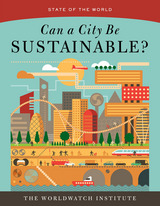
Can a City Be Sustainable? (State of the World)
The Worldwatch Institute
Island Press, 2016
Cities are the world’s future. Today, more than half of the global population—3.7 billion people—are urban dwellers, and that number is expected to double by 2050. There is no question that cities are growing; the only debate is over how they will grow. Will we invest in the physical and social infrastructure necessary for livable, equitable, and sustainable cities? In the latest edition of State of the World, the flagship publication of the Worldwatch Institute, experts from around the globe examine the core principles of sustainable urbanism and profile cities that are putting them into practice.
State of the World first puts our current moment in context, tracing cities in the arc of human history. It also examines the basic structural elements of every city: materials and fuels; people and economics; and biodiversity. In part two, professionals working on some of the world’s most inventive urban sustainability projects share their first-hand experience. Success stories come from places as diverse as Ahmedabad, India; Freiburg, Germany; and Shanghai, China. In many cases, local people are acting to improve their cities, even when national efforts are stalled. Parts three and four examine cross-cutting issues that affect the success of all cities. Topics range from the nitty-gritty of handling waste and developing public transportation to civic participation and navigating dysfunctional government.
Throughout, readers discover the most pressing challenges facing communities and the most promising solutions currently being developed. The result is a snapshot of cities today and a vision for global urban sustainability tomorrow.
State of the World first puts our current moment in context, tracing cities in the arc of human history. It also examines the basic structural elements of every city: materials and fuels; people and economics; and biodiversity. In part two, professionals working on some of the world’s most inventive urban sustainability projects share their first-hand experience. Success stories come from places as diverse as Ahmedabad, India; Freiburg, Germany; and Shanghai, China. In many cases, local people are acting to improve their cities, even when national efforts are stalled. Parts three and four examine cross-cutting issues that affect the success of all cities. Topics range from the nitty-gritty of handling waste and developing public transportation to civic participation and navigating dysfunctional government.
Throughout, readers discover the most pressing challenges facing communities and the most promising solutions currently being developed. The result is a snapshot of cities today and a vision for global urban sustainability tomorrow.
[more]
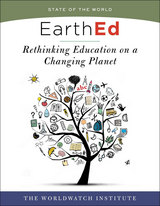
EarthEd (State of the World)
Rethinking Education on a Changing Planet
The Worldwatch Institute
Island Press, 2017
Earth education is traditionally confined to specific topics: ecoliteracy, outdoor education, environmental science. But in the coming century, on track to be the warmest in human history, every aspect of human life will be affected by our changing planet. Emerging diseases, food shortages, drought, and waterlogged cities are just some of the unprecedented challenges that today’s students will face. How do we prepare 9.5 billion people for life in the Anthropocene, to thrive in this uncharted and more chaotic future?
Answers are being developed in universities, preschools, professional schools, and even prisons around the world. In the latest volume of State of the World, a diverse group of education experts share innovative approaches to teaching and learning in a new era. Topics include systems thinking for kids; the importance of play in early education; social emotional learning; comprehensive sexuality education; indigenous knowledge; sustainable business; medical training to treat the whole person; teaching law in the Anthropocene; and more.
EarthEd addresses schooling at all levels of development, from preschool to professional. Its lessons can inform teachers, policy makers, school administrators, community leaders, parents, and students alike. And its vision will inspire anyone who wants to prepare students not only for the storms ahead but to become the next generation of sustainability leaders.
Answers are being developed in universities, preschools, professional schools, and even prisons around the world. In the latest volume of State of the World, a diverse group of education experts share innovative approaches to teaching and learning in a new era. Topics include systems thinking for kids; the importance of play in early education; social emotional learning; comprehensive sexuality education; indigenous knowledge; sustainable business; medical training to treat the whole person; teaching law in the Anthropocene; and more.
EarthEd addresses schooling at all levels of development, from preschool to professional. Its lessons can inform teachers, policy makers, school administrators, community leaders, parents, and students alike. And its vision will inspire anyone who wants to prepare students not only for the storms ahead but to become the next generation of sustainability leaders.
[more]
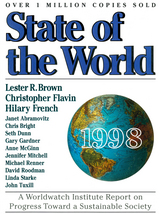
State of the World 1998
Environmental Threats of Economic Growth
The Worldwatch Institute
Island Press, 2015
In this fifteenth edition of State of the World, Lester R. Brown and the Worldwatch research team look at the environmental effects of continuing economic growth as the economy outgrows the earth's ecosystem. As the global economy has expanded from $5 trillion of output in 1950 to $29 trillion in 1997, its demands have crossed many of the earth's sustainable yield thresholds.
[more]
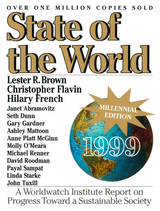
State of the World 1999
Looking Toward a Sustainable 21st Century
The Worldwatch Institute
Island Press, 2015
Written in clear and concise language, with easy-to-read charts and tables, State of the World presents a view of our changing world that we cannot afford to ignore.
[more]
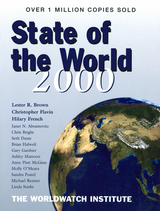
State of the World 2000
Building a Sustainable Economy
The Worldwatch Institute
Island Press, 2015
State of the World 2000 shines a sharp light on the great challenge our civilization faces: how to use our political systems to manage the difficult and complex relationships between the global economy and the Earth's ecosystems. If we cannot build an environmentally sustainable global economy, then we have no future that anyone would desire.
[more]
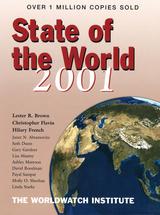
State of the World 2001
The Challenge of a Globalizing World
The Worldwatch Institute
Island Press, 2015
From the thinning of the Arctic sea ice to the invasion of the mosquito-borne West Nile virus, State of the World 2001 shows how the economic boom of the last decade has damaged natural systems. The increasingly visible evidence of environmental deterioration is only the tip of a much more dangerous problem: the growing inequities in wealth and income between countries and within countries, inequities that will generate enormous social unrest and pressure for change.
[more]
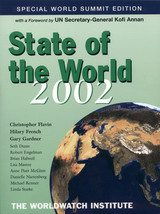
State of the World 2002
Addressing Climate Change and Overpopulation
The Worldwatch Institute
Island Press, 2015
State of the World 2002 includes chapters on climate change, farming, toxic chemicals, sustainable tourism, population, resource conflicts and global governance.
[more]
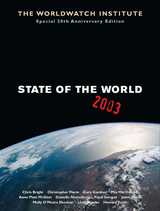
State of the World 2003
Reinventing Human Civilization
The Worldwatch Institute
Island Press, 2015
The challenges are still immense, of course, as the book also documents, but the building blocks for a historic reinvention of human civilization are now within reach.
[more]
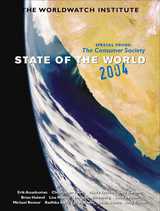
State of the World 2004
Special Focus: The Consumer Society
The Worldwatch Institute
Island Press, 2015
With chapters on food, water, energy, the politics of consumption and redefining the good life, Worldwatch’s award-winning research team asks whether a less-consumptive society is possible—and then argues that it is essential.
[more]
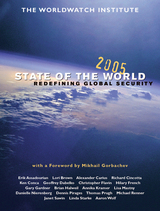
State of the World 2005
Redefining Global Security
The Worldwatch Institute
Island Press, 2015
In State of the World 2005, Worldwatch researchers explore underlying sources of global insecurity including poverty, infectious disease, environmental degradation, and rising competition over oil and other resources. Find out why terrorism is just symptomatic of a far broader set of complex problems that require more than a military response.
[more]
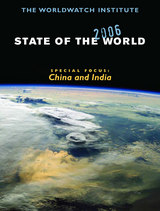
State of the World 2006
Special Focus: China and India
The Worldwatch Institute
Island Press, 2015
State of the World 2006 provides a special focus on China and India and their impact on the world as major consumers of resources and polluters of local and global ecosystems. The report explains the critical need for both countries to "leapfrog" the technologies, policies, and even the cultures that now prevail in many western countries for the sake of global sustainability—and reports on some of the strategies that China and India are starting to implement. Besides the focus on China and India, State of the World 2006 looks at actions corporations can take to be more socially responsible; examines the potential socioeconomic, health, and environmental implications of nanoscale technologies; assesses the impacts of large-scale development of biofuels on agriculture and the environment; describes mercury sources, industrial uses, and health hazards worldwide; and provides an overview of the need to safeguard freshwater ecosystems, with examples of proven approaches in cities, villages, and farming regions around the world.
[more]
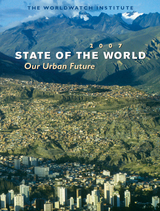
State of the World 2007
Our Urban Future
The Worldwatch Institute
Island Press, 2015
In 2008, half of the Earth’s population will live in urban areas, marking the first time in history that humans are an urban species. State of the World 2007: Our Urban Future examines changes in the ways cities are managed, built, and lived in that could tip the balance towards a healthier and more peaceful urban future.
[more]
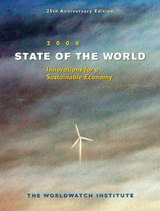
State of the World 2008
Innovations for a Sustainable Economy
The Worldwatch Institute
Island Press, 2015
Environmental issues were once regarded as irrelevant to economic activity, but today they are dramatically rewriting the rules for business, investors, and consumers. Around the world, innovative responses to climate change and other environmental problems are affecting more than $100 billion in annual capital flows as pioneering entrepreneurs, organizations, and governments take steps to create the Earth’s first “sustainable” global economy.
[more]
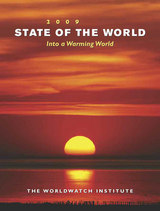
State of the World 2009
Into a Warming World
The Worldwatch Institute
Island Press, 2015
It's New Year's Day, 2101. Somehow, humanity survived the worst of global warming—the higher temperatures and sea levels and the more intense droughts and storms—and succeeded in stabilizing the Earth's climate. Greenhouse gas concentrations are peaking and are expected to drift downward in the 22nd century. The rise in global temperatures is slowing and the natural world is gradually healing. The social contract largely held. And humanity as a whole is better fed, healthier, and more prosperous today than it was a century ago. This scenario of an imagined future raises a key question: What must we do in the 21st century to make such a future possible, and to head off the kind of climate catastrophe that many scientists now see as likely? This question inspires the theme of the Worldwatch Institute's State of the World 2009 report: how climate change will play out over the coming century, and what steps we most urgently need to take now.
[more]
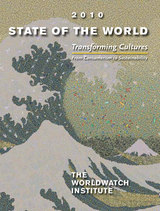
State of the World 2010
Transforming Cultures From Consumerism to Sustainability
The Worldwatch Institute
Island Press, 2015
Like a tsunami, consumerism has engulfed human cultures and Earth’s ecosystems. Left unaddressed, we risk global disaster. But if we channel this wave, intentionally transforming our cultures to center on sustainability, we will not only prevent catastrophe, but may usher in an era of sustainability—one that allows all people to thrive while protecting, even restoring, Earth. In State of the World 2010, sixty renowned researchers and practitioners describe how we can harness the world’s leading institutions—education, the media, business, governments, traditions, and social movements—to reorient cultures toward sustainability.
[more]
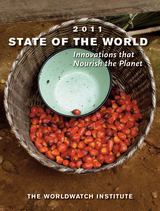
State of the World 2011
Innovations that Nourish the Planet
The Worldwatch Institute
Island Press, 2015
A compelling look at the global food crisis, with particular emphasis on global innovations that can help solve a worldwide problem. State of the World 2011 not only introduces us to the latest agro-ecological innovations and their global applicability but also gives broader insights into issues including poverty, international politics, and even gender equity.
[more]
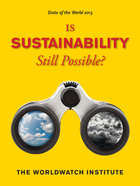
State of the World 2013
Is Sustainability Still Possible?
The Worldwatch Institute
Island Press, 2013
Every day, we are presented with a range of “sustainable” products and activities—from “green” cleaning supplies to carbon offsets—but with so much labeled as “sustainable,” the term has become essentially sustainababble, at best indicating a practice or product slightly less damaging than the conventional alternative. Is it time to abandon the concept altogether, or can we find an accurate way to measure sustainability? If so, how can we achieve it? And if not, how can we best prepare for the coming ecological decline?
In the latest edition of Worldwatch Institute’s State of the World series, scientists, policy experts, and thought leaders tackle these questions, attempting to restore meaning to sustainability as more than just a marketing tool. In State of the World 2013: Is Sustainability Still Possible?, experts define clear sustainability metrics and examine various policies and perspectives, including geoengineering, corporate transformation, and changes in agricultural policy, that could put us on the path to prosperity without diminishing the well-being of future generations. If these approaches fall short, the final chapters explore ways to prepare for drastic environmental change and resource depletion, such as strengthening democracy and societal resilience, protecting cultural heritage, and dealing with increased conflict and migration flows.
State of the World 2013 cuts through the rhetoric surrounding sustainability, offering a broad and realistic look at how close we are to fulfilling it today and which practices and policies will steer us in the right direction. This book will be especially useful for policymakers, environmental nonprofits, and students of environmental studies, sustainability, or economics.
In the latest edition of Worldwatch Institute’s State of the World series, scientists, policy experts, and thought leaders tackle these questions, attempting to restore meaning to sustainability as more than just a marketing tool. In State of the World 2013: Is Sustainability Still Possible?, experts define clear sustainability metrics and examine various policies and perspectives, including geoengineering, corporate transformation, and changes in agricultural policy, that could put us on the path to prosperity without diminishing the well-being of future generations. If these approaches fall short, the final chapters explore ways to prepare for drastic environmental change and resource depletion, such as strengthening democracy and societal resilience, protecting cultural heritage, and dealing with increased conflict and migration flows.
State of the World 2013 cuts through the rhetoric surrounding sustainability, offering a broad and realistic look at how close we are to fulfilling it today and which practices and policies will steer us in the right direction. This book will be especially useful for policymakers, environmental nonprofits, and students of environmental studies, sustainability, or economics.
[more]
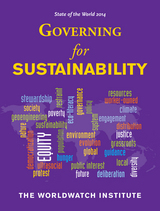
State of the World 2014
Governing for Sustainability
The Worldwatch Institute
Island Press, 2014
Citizens expect their governments to lead on sustainability. But from largely disappointing international conferences like Rio II to the U.S.’s failure to pass meaningful climate legislation, governments’ progress has been lackluster. That’s not to say leadership is absent; it just often comes from the bottom up rather than the top down. Action—on climate, species loss, inequity, and other sustainability crises—is being driven by local, people’s, women’s, and grassroots movements around the world, often in opposition to the agendas pursued by governments and big corporations.
These diverse efforts are the subject of the latest volume in the Worldwatch Institute’s highly regarded State of the World series. The 2014 edition, marking the Institute’s 40th anniversary, examines both barriers to responsible political and economic governance as well as gridlock-shattering new ideas. The authors analyze a variety of trends and proposals, including regional and local climate initiatives, the rise of benefit corporations and worker-owned firms, the need for energy democracy, the Internet’s impact on sustainability, and the importance of eco-literacy. A consistent thread throughout the book is that informed and engaged citizens are key to better governance.
The book is a clear-eyed yet ultimately optimistic assessment of citizens’ ability to govern for sustainability. By highlighting both obstacles and opportunities, State of the World 2014 shows how to effect change within and beyond the halls of government. This volume will be especially useful for policymakers, environmental nonprofits, students of environmental studies, sustainability, or economics—and citizens looking to jumpstart significant change around the world.
These diverse efforts are the subject of the latest volume in the Worldwatch Institute’s highly regarded State of the World series. The 2014 edition, marking the Institute’s 40th anniversary, examines both barriers to responsible political and economic governance as well as gridlock-shattering new ideas. The authors analyze a variety of trends and proposals, including regional and local climate initiatives, the rise of benefit corporations and worker-owned firms, the need for energy democracy, the Internet’s impact on sustainability, and the importance of eco-literacy. A consistent thread throughout the book is that informed and engaged citizens are key to better governance.
The book is a clear-eyed yet ultimately optimistic assessment of citizens’ ability to govern for sustainability. By highlighting both obstacles and opportunities, State of the World 2014 shows how to effect change within and beyond the halls of government. This volume will be especially useful for policymakers, environmental nonprofits, students of environmental studies, sustainability, or economics—and citizens looking to jumpstart significant change around the world.
[more]
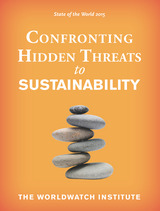
State of the World 2015
Confronting Hidden Threats to Sustainability
The Worldwatch Institute
Island Press, 2015
We think we understand environmental damage: pollution, water scarcity, a warming world. But these problems are just the tip of the iceberg. Food insecurity, financial assets drained of value by environmental damage, and a rapid rise in diseases of animal origin are among the underreported consequences of an unsustainable global system.
In State of the World 2015, the flagship publication of The Worldwatch Institute, experts explore hidden threats to sustainability and how to address them. How will nations deal with migration as climate change refugees cross borders in order to escape flooding, drought, or other extreme weather events? What will happen to the price and availability of fossil energy—the foundation of industrial civilization--as these resources oscillate between surplus and scarcity? If perpetual economic growth on a finite planet is impossible, what are the alternatives? Can national governments manage the transition? Eight key issues are addressed in depth, along with the central question of how we can develop resilience to these and other shocks.
For decades, The Worldwatch Institute has been a leader in identifying and analyzing emerging environmental threats. With the latest edition of State of The World, the authorities at Worldwatch bring to light challenges we can no longer afford to ignore.
In State of the World 2015, the flagship publication of The Worldwatch Institute, experts explore hidden threats to sustainability and how to address them. How will nations deal with migration as climate change refugees cross borders in order to escape flooding, drought, or other extreme weather events? What will happen to the price and availability of fossil energy—the foundation of industrial civilization--as these resources oscillate between surplus and scarcity? If perpetual economic growth on a finite planet is impossible, what are the alternatives? Can national governments manage the transition? Eight key issues are addressed in depth, along with the central question of how we can develop resilience to these and other shocks.
For decades, The Worldwatch Institute has been a leader in identifying and analyzing emerging environmental threats. With the latest edition of State of The World, the authorities at Worldwatch bring to light challenges we can no longer afford to ignore.
[more]
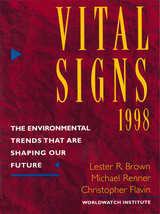
Vital Signs 1998
The Environmental Trends That Are Shaping Our Future
The Worldwatch Institute
Island Press, 1998
The new Vital Signs 1998 gives you more than 100 charts, graphs and tables that show you the worldwide trends that are changing our lives, for better and for worse. It includes the latest data on critical global trends, presented in simple but compelling graphics, along with concise, thoughtful analysis.
[more]
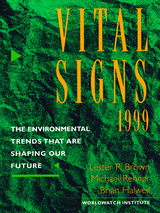
Vital Signs 1999
The Environmental Trends That Are Shaping Our Future
The Worldwatch Institute
Island Press, 2015
The global trends documented in Vital Signs 1999—from a decline in nuclear power generating capacity to the proliferation of genetically modified crops—will play a large part in determining the quality of our lives and our children's lives in the next decade.
[more]
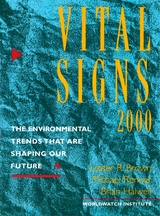
Vital Signs 2000
The Environmental Trends That Are Shaping Our Future
The Worldwatch Institute
Island Press, 2015
The global trends documented in Vital Signs 2000—from the rapid rise in the sales of energy-efficient compact fluorescent lamps to the worldwide overpumping of growndwater—will play a large role in determining the quality of our lives and our children's lives in the next decade.
[more]
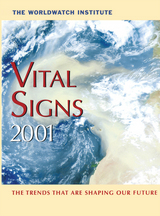
Vital Signs 2001
The Trends That Are Shaping Our Future
The Worldwatch Institute
Island Press, 2015
The global trends documented in Vital Signs 2001—from the rapid increase in the use of wind power to the continued warming of the planet—will play a large role in determining the quality of our lives and our children's lives in this new century.
[more]
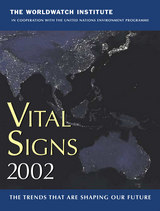
Vital Signs 2002
The Trends That Are Shaping Our Future
The Worldwatch Institute
Island Press, 2015
The 2002 edition features more than 50 key indicators of long-term trends—from the growth of fish farms and bicycle production to the increase in solar cell and Internet use.
[more]
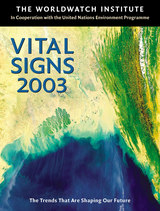
Vital Signs 2003
The Trends That Are Shaping Our Future
The Worldwatch Institute
Island Press, 2015
With Vital Signs 2003, you’ll have the cogent analysis you need to prepare for tomorrow’s challenges.
[more]
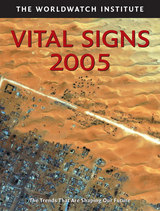
Vital Signs 2005
The Trends That Are Shaping Our Future
The Worldwatch Institute
Island Press, 2015
This much-anticipated edition of Vital Signs covers 35 global trends that are shaping our future. From carbon emissions to loss of wetlands, each trend provides a brief status report on the topic plus graphs and charts that offer a visual comparison over time. Categories include Food, Economics, Transportation, Health, Governance, Energy and Climate, and Conflict and Peace.
[more]
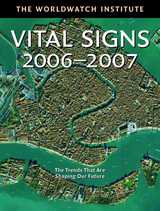
Vital Signs 2006-2007
The Trends That Are Shaping Our Future
The Worldwatch Institute
Island Press, 2015
This report tracks and analyzes 44 trends that are shaping our future, and includes graphs and charts to provide a visual comparison over time. Categories of trends include: Food, Agricultural Resources, Energy and Climate, Global Economy, Resource Economics, Environment, War and Conflict, Communications and Transportation, Population and Society, and Health and Disease.
[more]
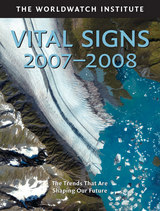
Vital Signs 2007-2008
The Trends That Are Shaping Our Future
The Worldwatch Institute
Island Press, 2015
This report tracks and analyzes 44 trends that are shaping our future, and includes graphs and charts to provide a visual comparison over time. Categories of trends include: Food, Agricultural Resources, Energy and Climate, Global Economy, Resource Economics, Environment, Conflict and Peace, Communications and Transportation, Population and Society, and Health and Disease.
[more]
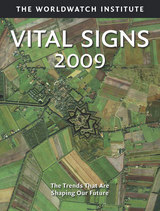
Vital Signs 2009
The Trends That Are Shaping Our Future
The Worldwatch Institute
Island Press, 2015
This sixteenth volume of Worldwatch’s Vital Signs series makes it clear that climate change is both a growing driver of and an increasingly important motivator behind the world’s leading economic, social, and environmental trends.
[more]
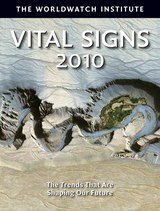
Vital Signs 2010
The Trends That Are Shaping Our Future
The Worldwatch Institute
Island Press, 2015
This seventeenth edition of the Worldwatch Institute series shows that climate change continues to cast a long shadow over the world’s leading economic, social, and environmental trends.
[more]
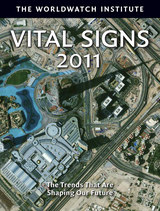
Vital Signs 2011
The Trends That Are Shaping Our Future
The Worldwatch Institute
Island Press, 2015
This eighteenth volume of the Worldwatch Institute series makes it clear that the Great Recession affects many of the world’s leading economic, social, and environmental trends—but that the impact can be very different by country.
[more]
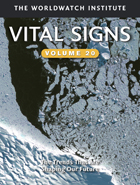
Vital Signs Volume 20
The Trends that are Shaping Our Future
The Worldwatch Institute
Island Press, 2013
From meat consumption to automobile production to hydropower, Vital Signs, Volume 20 documents over two dozen trends that are shaping our future in concise analyses and clear tables and graphs. The twentieth volume of the Worldwatch Institute series demonstrates that while remarkable progress has been made over the past year, much remains to be done to get the planet on a more sustainable track.
Worldwide, people are waking up to the realities of a resource-constrained planet: investments and subsidies for renewable energy have reached new heights, consumers are slowly shifting away from meat-heavy diets, and new employment structures like co-operatives are democratizing the global economy. Yet with over 1 billion people lacking access to electricity, natural disasters that are more costly than ever before, and an adherence to the factory farm model of food production, it is clear that many obstacles loom on the horizon.
Covering a wide range of environmental, economic, and social themes, Vital Signs, Volume 20 is the go-to source for straightforward data and analyses on the latest issues facing an increasingly crowded planet. By placing each trend within a global framework, Vital Signs, Volume 20 identifies the solutions we need to transition toward a more sustainable world.
This book will be especially useful for policymakers, environmental nonprofits, and students of environmental studies, sustainability, or economics.
Worldwide, people are waking up to the realities of a resource-constrained planet: investments and subsidies for renewable energy have reached new heights, consumers are slowly shifting away from meat-heavy diets, and new employment structures like co-operatives are democratizing the global economy. Yet with over 1 billion people lacking access to electricity, natural disasters that are more costly than ever before, and an adherence to the factory farm model of food production, it is clear that many obstacles loom on the horizon.
Covering a wide range of environmental, economic, and social themes, Vital Signs, Volume 20 is the go-to source for straightforward data and analyses on the latest issues facing an increasingly crowded planet. By placing each trend within a global framework, Vital Signs, Volume 20 identifies the solutions we need to transition toward a more sustainable world.
This book will be especially useful for policymakers, environmental nonprofits, and students of environmental studies, sustainability, or economics.
[more]
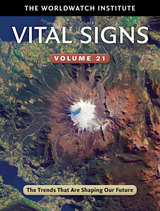
Vital Signs Volume 21
The Trends That Are Shaping Our Future
The Worldwatch Institute
Island Press, 2015
Vital Signs Volume 21 is all about growth. From natural disasters to cars to organic farming, the two dozen trends examined here indicate both increasing pressure on natural resources and scaled up efforts to live more sustainably.
In 2012, world auto production set yet another record with passenger-car production rising to 66.7 million. That same year, the number of natural disasters climbed to 905, roughly one hundred more than the 10-year annual average, and 90 percent were weather related. Alongside these mounting pressures come investments in renewable energy and sustainable agriculture. The number of acres of land farmed organically has tripled since 1999, though it still makes up less than 1% of total farmland.
Not all the statistics are going up. Key measures of development aid have fallen, as have global commodity prices. Yet the overall trend is expansion, both for the good and ill of the planet. Vital Signs provides the latest data available, but its value goes beyond simple numbers. Through insightful analysis of global trends, it offers a starting point for those seeking solutions to the future’s intensifying challenges.
[more]
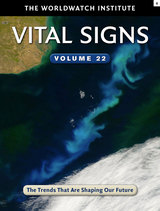
Vital Signs Volume 22
The Trends That Are Shaping Our Future
The Worldwatch Institute
Island Press, 2015
What we make and buy is a major indicator of society’s collective priorities. Among twenty-four key trends, Vital Signs Volume 22 explores significant global patterns in production and consumption. The result is a fascinating snapshot of how we invest our resources and the implications for the world’s well-being.
The book examines developments in six main areas: energy, environment and climate, transportation, food and agriculture, global economy and resources, and population and society. Readers will learn how aquaculture is making gains on wild fish catches, where high speed rail is accelerating, why plastic production is on the rise, who is escaping chronic hunger, and who is still suffering.
Researchers at the Worldwatch Institute not only provide the most up-to-date statistics, but put them in context. The analysis in Vital Signs teaches us both about our current priorities and how they could be shaped to create a better future.
The book examines developments in six main areas: energy, environment and climate, transportation, food and agriculture, global economy and resources, and population and society. Readers will learn how aquaculture is making gains on wild fish catches, where high speed rail is accelerating, why plastic production is on the rise, who is escaping chronic hunger, and who is still suffering.
Researchers at the Worldwatch Institute not only provide the most up-to-date statistics, but put them in context. The analysis in Vital Signs teaches us both about our current priorities and how they could be shaped to create a better future.
[more]
READERS
Browse our collection.
PUBLISHERS
See BiblioVault's publisher services.
STUDENT SERVICES
Files for college accessibility offices.
UChicago Accessibility Resources
home | accessibility | search | about | contact us
BiblioVault ® 2001 - 2024
The University of Chicago Press









